

Ed Online - Original Lesson Plans. Financial Literacy Begins at School! According to the National Endowment for Financial Education, as few as ten hours of classroom instruction can be enough to persuade students to improve their spending and saving habits.
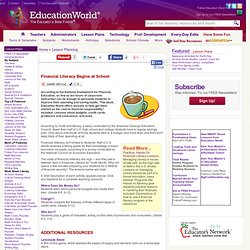
This week, Education World offers lessons to help get them started on the road to financial responsibility! Included: Lessons about budgets, credit cards, producers and consumers, and more. According to Youth and Money, a study conducted by the American Savings Education Council, fewer than half of U.S. high school and college students have a regular savings plan. Only about one-fourth of those students stick to a budget, and more than one-third don't keep track of their spending at all. Financial illiteracy isn't limited to students.
The costs of financial illiteracy are high -- and they last a lifetime! A brief description of each activity appears below. Where Does the Money Go? Charge!? Who Am I? Consumer.gov The U.S. government maintains this one-stop source for federal consumer information. Eleventh and Twelfth Grade Money Skills, Teaching High School, Economics, Business. Back to Basic Economics Lessons Eleventh and twelve grade students are familiar with choosing electives and by this age, have a better understanding of what interests them and what they want to learn more about.
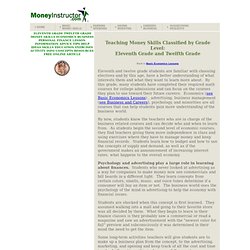
By this grade, many students have completed their required math courses for college admissions and can focus on the courses they plan to use toward their future careers. Economics (see Basic Economics Lessons) , advertising, business management (see Business and Careers), psychology, and minorities are all courses that can help students gain more understanding of the business world. By now, students know the teachers who are in charge of the business related courses and can decide who and when to learn from. Financial Literacy for High School Students.
If you have followed the news lately, you have likely read about the looming college debt crisis. In October, the Economist published The Next Big Credit Bubble, and soon thereafter TIME Magazine published College Graduates Face Record-High Debt In the Age of Record-High Unemployment which is essentially saying the same thing.
Some high school students are getting the message, and we need to make sure they react appropriately. College is an investment in yourself, and like any investment, you should spend the appropriate amount of money for the anticipated return on your investment. In other words, do not go $200,000 into debt majoring in French poetry. One of the greatest obstacles to financial literacy is overcoming students' fear of certain financial tools. UtahFutures - Education and Career Planning. It's About Supply and Demand. What's My Score. What's Up In Finance? . For Educators . Overview.
In today’s complex world, young people need financial savvy more than ever.
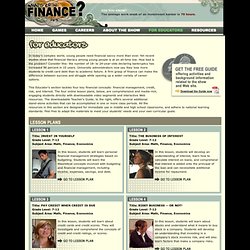
Yet recent studies show that financial literacy among young people is at an all-time low. How bad is the problem? Consider this: the number of 18- to 24-year-olds declaring bankruptcy has increased 96 percent in 10 years. University administrators now say they lose more students to credit card debt than to academic failure. A firm grasp of finance can make the difference between success and struggle while opening up a wider variety of career options. Classroom Resource Resources with the subject "family-consumer-science" iPracticeMath is a great site for teaching, reinforcing and reviewing math skills for all grade levels.
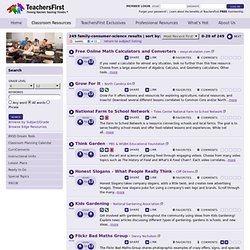
The site is intended for home use, with parents registering to track their child's progress, but registration is not required to access activities. Begin by choosing from math practice, learning, or worksheets. From there choose a grade level and content. In addition to the usual math topics, there is Consumer Math. Answer multiple choice questions that provide immediate feedback including correct responses for incorrect answers. Teacher Lesson Plans Economics and Personal Finance Philadelphia Fed. All Lessons Uncle Jed's Barbershop (9-11 years) Children's Literature Lesson Description: Students listen to the book Uncle Jed’s Barbershop, about an African-American barber who, despite significant setbacks, saves enough money to buy his own barbershop.
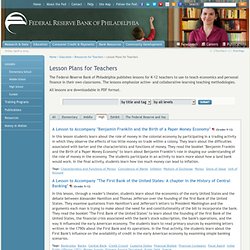
From the story, students learn about saving, savings goals, opportunity cost, and segregation. The students participate in a card game to further investigate what it takes to reach a savings goal. A Lesson to Accompany "The First Bank of the United States: A chapter in the History of Central Banking" (Grades 9-12) In this lesson, through a reader’s theater, students learn about the economics of the early United States and the debate between Alexander Hamilton and Thomas Jefferson over the founding of the first Bank of the United States.
The Goat in the Rug (8-10 years) Children's Literature Ten Mile Day. A premier source of classroom tested, Internet-based economic lesson materials for K-12 teachers and their students. Money Smart - A Financial Education Program. Money Smart is a comprehensive financial education curriculum designed to help low- and moderate-income individuals outside the financial mainstream enhance their financial skills and create positive banking relationships.

Money Smart has reached over 2.75 million consumers since 2001. Research shows that the curriculum can positively influence how consumers manage their finances, and these changes are sustainable in the months after the training. Jump$tart.org. NEFE High School Financial Planning Program. Credit Card Management. Money Management & Financial Planning.